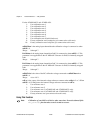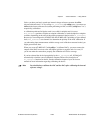
Chapter 2 Function Reference — RTSI_Conn
NI-DAQ FRM for PC Compatibles 2-290
©
National Instruments Corporation
The second call could access another non-E Series MIO or AI device and use parameters
sigCode = 0, trigLine = 3, and dir = 0. This call configures the second non-E Series MIO or
AI device RTSI interface to receive a signal from trigger line 3 and drive it onto the non-E
Series MIO or AI device EXTCONV* signal. The total effect of these two calls is that the
non-E Series MIO or AI device EXTCONV* signal on the second device is controlled by the
OUT1 signal on the first MIO or AI device, thus controlling A/D conversions on the second
non-E Series MIO or AI device by a counter on the first.
Note If you are using an E Series device, see the Select_Signal function.
Rules for RTSI Bus Connections
Observe the following rules when routing signals over the RTSI bus trigger lines:
• You can connect any signal to any trigger line.
• RTSI connections should have only one source signal but can have multiple receiver
signals. Connecting two or more source signals causes bus contention over the trigger
line.
• You can connect two or more signals on the same device together using a RTSI bus
trigger line as long as you follow the above rules.
You can disconnect RTSI connections by using either
RTSI_DisConn or RTSI_Clear.


















